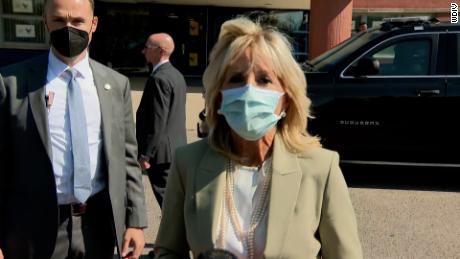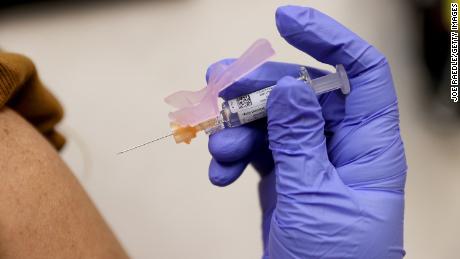(CNN)US health officials are bracing for a trio of public health concerns this winter: more infections from the Omicron variant of the coronavirus, surging infections with the Delta variant, and a "slow but steady" comeback of the flu.
There is growing concern that a rise in Omicron cases, paired with climbing Delta cases and an increase in flu cases, could overwhelm health systems this winter, as well as possibly leading to a need to ramp up Covid-19 testing capacities, Lori Tremmel Freeman, chief executive officer of the National Association of County and City Health Officials (NACCHO), told CNN on Wednesday.
"It's the combination. It's kind of the perfect storm of public health impacts here with Delta already impacting many areas of the country and jurisdictions," Freeman said. "We don't want to overwhelm systems more."
After circulating at nearly nonexistent levels last year, the flu is reappearing in certain areas across the United States, Dr. Manish Patel, team lead for the influenza prevention and control team at the US Centers for Disease Control and Prevention, said during a call hosted by the CDC's Clinician Outreach and Communication Activity (COCA) group last week.
"We do know influenza is going to come back and already has started to reappear in many places in the United States," Patel said.
Now, health officials and doctors are preparing for more illness this winter.
'It makes sense for us to be prepared'
The nation continues to grapple with the coronavirus pandemic, and health officials worry about adding flu patients to this burden.
"It makes sense for us to be prepared and maintain vigilance for influenza," Patel said.
He added that flu activity is unpredictable.
"Last year or last season -- really, in the past 18 months -- we have had no influenza activity in the United States and minimal activity globally in the Southern Hemisphere or the Northern Hemisphere. And this really has not happened before since we've had surveillance for influenza," Patel said. "The jury is still out on reasons why that hasn't happened."
In the first week of December, 841 people were admitted to US hospitals with influenza, according to the CDC. That's up from the prior week, when there were 496 new flu admissions.
"Overall, influenza activity is still low; however, an increasing number of influenza positive tests have been reported by clinical and public health laboratories during recent weeks," the CDC said in its weekly flu report. The majority of flu viruses were detected in young people, ages 5 to 24, but the proportion of flu virus detections among adults 25 and older has increased in recent weeks.
In late November, the CDC said increased flu activity has been detected among young adults and college students, which could mean the start of a new flu season. The agency also noted that as the flu and the virus that causes Covid-19 both circulate, the combination could stress health care systems throughout the United States.
Worry about a winter wave
"We are already in a Delta surge," Dr. Anthony Fauci, director of the National Institute of Allergy and Infectious Diseases, told CNN's Wolf Blitzer on Wednesday night.
"The cases are going up. We have an average of about 117,000 cases. We have an increase in the percentage of hospitalizations. Deaths are still over a thousand," Fauci said. "Then you have, looking over your shoulder, the Omicron variant, which we know, from what's going on in South Africa and in the UK, is a highly transmissible virus.
"That's the reason why we are encouraging people, if they haven't been vaccinated, to get vaccinated but, as importantly, for those who've been fully vaccinated to get a booster."
The United States is averaging 119,888 new Covid-19 cases each day, according to data from Johns Hopkins University, as of Wednesday. This is about 50% higher than a month ago.
The United States is now also averaging 1,261 deaths each day, according to JHU. This is 5% higher than a month ago.
There are 67,306 people now hospitalized with Covid-19, according to the US Department of Health and Human Services. Hospitalizations have been trending up for more than two months, and this is 43% higher than a month ago.
This January, the United States could face a surge of Covid-19 cases, with the Omicron variant possibly contributing to the winter wave, according to modeling data that was presented to state and local health officials during a call with the CDC on Tuesday.
But that's just one possible scenario.
The CDC told CNN in a written statement Tuesday that the agency "regularly discusses planning scenarios with public health officials around the country," and Tuesday's discussion "was part of a regularly scheduled meeting hosted by the CDC COVID-19 Response with the leaders of four public health organizations."
The statement noted that the CDC is "preparing for a range of scenarios" involving the Omicron variant, and a portion of Tuesday's meeting was dedicated to "discussion around results from various modeling groups related to Omicron" -- but no CDC, US Department of Health and Human Services or US government models were presented.
The modeling information, along with data from Europe, indicates that the number of Covid-19 cases caused by the Omicron variant has the potential to double every two days, NACCHO's Freeman told CNN.
"When you think about how this virus has the potential to double every two days, then in a couple of weeks, we're going to be facing a lot of cases of Omicron," said Freeman, who was on part of Tuesday's call.
"That modeling implies that sometime in January, we will be at a different stage of recognizing Omicron, maybe as even a predominant virus. However, we still are learning about the severity, transmissibility," Freeman said. "The data is emerging from around the world."
The proportion of Omicron cases in the United States is expected to "continue to grow in the coming weeks," CDC Director Dr. Rochelle Walensky said during a virtual White House briefing Wednesday. She added that early data suggests Omicron is more transmissible than Delta, with a doubling time of about two days.
While the Delta variant continues to cause the most Covid-19 cases in the United States, Omicron has gone from causing 0.4% of cases in the week ending December 4 to 2.9% of cases in the week ending December 11, according to CDC data.
Currently, CDC data indicates that Delta causes 96.8% of cases.
'We are definitely seeing an uptick in both infections'
Dr. Christina Johns, a pediatrician in Annapolis, Maryland, told CNN last week that there has been a "slow but steady" increase in patients testing positive for flu and Covid-19 in her pediatric network in recent weeks.
"We are definitely seeing an uptick in both infections over the last week," said Johns, emergency medicine physician and senior medical adviser for PM Pediatrics, which has more than 70 pediatric office locations across the United States.
"We are starting to see a slow and steady trickle of an increase of cases. And why is that? Well, because this is the time of year when we typically start to see influenza begin to circulate," she said. "But why aren't we seeing the explosive uptick? One reason is that school-aged children are still largely masked in many school districts, and so I think that that helps to keep numbers down. The overall layered protective measures that are still in place in many areas are effective for both Covid as well as influenza."
This winter, Johns said, there is the concern of a potential "twindemic" of Covid-19 and flu, and it's important for people with any respiratory symptoms this season to see their doctor immediately for testing.
She said when young people -- up to age 26 -- come into her office with symptoms, such as a cough, fever or runny nose, the only way to determine whether they have the flu, Covid-19 or a common cold is through testing.
Get CNN Health's weekly newsletter
Sign up here to get The Results Are In with Dr. Sanjay Gupta every Tuesday from the CNN Health team.
"I think that that's an important point that needs to be made, especially right now while we are still in the midst of this pandemic," Johns said.
"It is difficult to tell the difference without a test. There are some trends. Typically for influenza, the clinical hallmark is high fever, and that occurs less so in the common cold and is not always a feature of Covid-19 infection," Johns said. "But none of that is 100%, and there's enough overlap in all three of these that, really, the only way to know the difference is through testing."

























